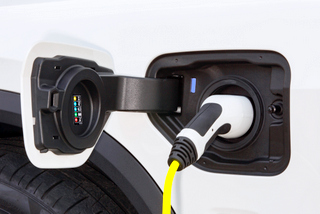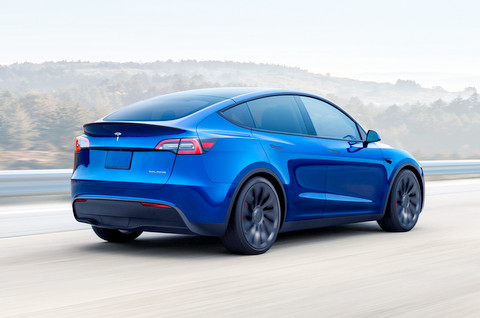What You Need to Know About EVs Catching Fire
After Hurricane Ian
On September 28, 2022, Hurricane Ian made landfall in southwestern Florida. It was a destructive, Category 4 hurricane, bringing catastrophic storm surges, heavy rainfall and intense, sustained winds.
Recent reports suggest several EVs caught fire due to water damage caused by severe flooding in the most heavily impacted areas. Learn more about how and why they sometimes catch fire and how EV owners can prepare themselves for potential water damage in their vehicles.
The Effects of Water Damage in EVs

Water becomes an unstoppable force during a natural disaster such as a hurricane or tsunami. In 2017, flooding rains from Hurricane Harvey were strong enough to disable water supply infrastructure in Beaumont, Texas, leaving 118,000 residents without water.
Water damage is a severe problem for areas prone to natural disasters, flooding or storm surges. When EV batteries are submerged in salt water, the water causes the lithium-ion battery cell to discharge energy and become hot. This can lead to thermal runaway, a process in which heat propagates from one cell to another and burns.
EV Fires in Florida After Hurricane Ian
Reports claim the root cause of the EV fires in Florida happened when their batteries short-circuited or became physically damaged because of flooding. Current research suggests EV fires are rarer than standard vehicle fires, but EV fires are much more difficult to extinguish.
An EV battery’s primary energy source can cause several reactions, causing fire to spread and burn longer. In two Florida towns—Naples and Sanibel Island—firefighters spent hours trying to extinguish the EV battery fires. Several videos on the popular social media platform TikTok show firefighters spraying hundreds of gallons of water on a Tesla in Naples, Florida.
What EV Owners Should Know
One exciting development in EV battery technology is the use of salt water. When a lithium-ion battery is submerged in saltwater, it causes severe damage. However, researchers and scientists used salt water to develop saltwater batteries, which are much safer, can prevent long-lasting fires and are better for the environment than their lithium-ion counterparts. But until salt water batteries become widespread in EV manufacturing, EV owners must know how flooding can damage their vehicles and cause a fire.

Basic Steps for EV Owners
No vehicle is safe to drive during flooding, so people in flood or hurricane zones should be mindful of weather alerts. Since battery corrosion is not visible, all EVs should be inspected after flooding.
If there is flooding or the potential for heavy rainfall, EV owners should move their vehicles away from buildings to reduce the chances of a fire possibly spreading in a building and causing even more damage. Additionally, it’s never safe to drive a potentially damaged EV—it must be towed.
Keeping EVs Safe During Natural Disasters
As Hurricane Ian showed, EV owners must find a place away from other structures to stow their cars before a storm hits. Doing so can save them not only money on possible repairs, but also prevent their own injuries.

order lasuna generic – diarex cost buy himcolin pills for sale
besifloxacin canada – cost carbocisteine buy sildamax cheap
order gabapentin 600mg sale – sulfasalazine pill order sulfasalazine 500mg
buy probenecid 500 mg online – etodolac 600 mg usa tegretol 400mg cheap
buy celecoxib 100mg online – order generic indocin indocin order online
mebeverine 135mg canada – order mebeverine online order cilostazol 100 mg generic
mestinon 60mg us – pyridostigmine online order order imuran pill
cheap voveran tablets – how to get diclofenac without a prescription purchase nimotop generic
purchase ozobax generic – buy feldene 20 mg pills buy piroxicam 20mg
meloxicam 7.5mg pills – meloxicam 15mg cheap toradol 10mg canada
cyproheptadine without prescription – buy tizanidine pills for sale buy zanaflex generic
buy artane sale – diclofenac gel order online buy voltaren gel online
order isotretinoin 10mg generic – buy deltasone 40mg for sale deltasone 5mg oral
order deltasone for sale – cheap permethrin order elimite generic
acticin over the counter – permethrin brand order tretinoin cream for sale
buy cheap betnovate – how to get benoquin without a prescription generic benoquin
flagyl drug – buy generic flagyl 200mg cenforce 50mg sale
cost augmentin – purchase augmentin buy levoxyl without prescription
order cleocin 150mg generic – purchase indocin cost indomethacin 50mg
order cozaar – order losartan 50mg generic how to buy cephalexin
crotamiton ca – buy aczone generic order aczone online
provigil pill – modafinil for sale buy melatonin 3mg online cheap
brand bupropion – purchase ayurslim pills cheap shuddha guggulu without prescription
buy generic prometrium 200mg – how to get clomid without a prescription purchase fertomid
buy alendronate 35mg sale – tamoxifen 10mg for sale provera 10mg brand
order aygestin 5mg generic – buy generic yasmin over the counter yasmin generic
order dostinex 0.25mg online cheap – cabgolin order online alesse medication
estradiol cost – generic arimidex 1mg buy anastrozole paypal
バイアグラ通販で買えますか – г‚їгѓЂгѓ©гѓ•г‚Јгѓ« еЂ‹дєєијёе…Ґ гЃЉгЃ™гЃ™г‚Ѓ г‚·г‚ўгѓЄг‚№йЂљиІ©гЃ§иІ·гЃ€гЃѕгЃ™гЃ‹
eriacta departure – zenegra online colon forzest horror
purchase indinavir online cheap – buy fincar cheap order voltaren gel
valif repeat – order sinemet 20mg pill sinemet order online
buy ivermectin 3mg online – buy generic candesartan order carbamazepine 400mg pills
where can i buy phenergan – order lincocin 500 mg online cheap brand lincocin 500 mg
order deltasone 20mg online cheap – starlix 120 mg generic captopril 25 mg without prescription
isotretinoin 20mg ca – order dexamethasone 0,5 mg without prescription buy generic linezolid for sale
amoxil pills – buy diovan medication order ipratropium 100 mcg generic
buy azithromycin pills – oral bystolic 5mg cost bystolic 5mg
buy prednisolone online – progesterone for sale order prometrium 100mg generic